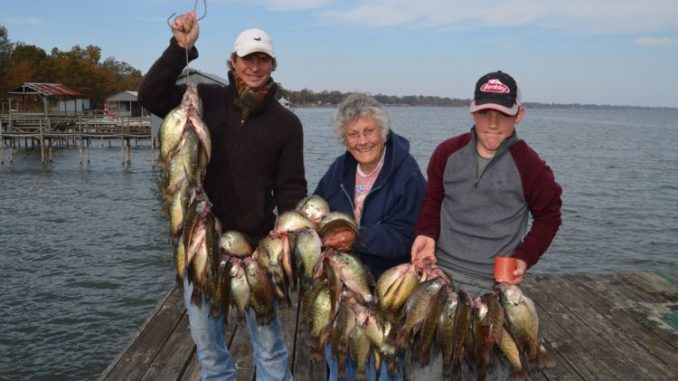
At first glance, the fish house used by Dorothy Williams and Josh Andrews appears unpretentious. But closer inspection reveals that a lot of thought went into its design and a lot of labor goes into its maintenance.
Location is of prime importance, according to Andrews. This one is set in 20 feet of water in the former channel of the Mississippi River before the river abandoned it, forming the oxbow lake.
The thought of the cost of purchase and installation of the massive pilings is sobering. Twenty-six feet of piling are exposed above the bottom, plus much more piling is driven into the bottom to create a stable platform.
The dimensions of the metal-skinned fish house itself are approximately 20 feet by 30 feet, not including a wide walk-around porch. Six-foot long pieces of heavy conveyor belt are attached side-by-side around the perimeter of the porch.
They are long enough to extend to just below the water’s surface at normal water levels. Their purpose is to provide dense shade under the fish house by preventing light from entering from the sides. “White perch like it dark,” Andrews explained.
The actual fishing area is indoors — a 6-foot wide deck covered with indoor-outdoor carpeting. Anglers stand or sit on this deck and fish in the rectangular open area in the center of the house.
Only one small window is placed in each wall and each has blinds or heavy curtins. The interior walls and ceiling are painted dull brown. Both measures are to aid in keeping light muted to enhance the house’s fish-attracting ability.
The house is wired and has a wall heater, a refrigerator, and electrical outlets. It also has a sink, a small cupboard, two rod racks, a pegboard to hold packs of jig tails, and a liberal supply of folding chairs.
Even more efforts to make the fish house attractive to white perch go on underwater. Much of the action takes place under the 6-foot wide inner deck and the 10-foot wide outer porch.
Andrews stabs pecan limbs and bamboo canes into buckets of concrete and sinks them after they harden. He does the same with PVC “trees” constructed of 4-inch pipe for the vertical “stem,” and 1-inch “branches extending in every direction horizontally.” He extends ropes tied to the tops of the PVC trees up to the fish house frame to keep the trees in vertical position.
None of these materials are placed in the open square inside the fish house to reduce hang-ups. All are placed under the deck and porch.
He also dumps bricks, concrete blocks and tombstones under the fish house.
“Tombstones?” I asked.
“Yes, tombsones,” he laughed. “I’ve got a buddy who owns a monument company. He gives me any broken or misprinted tombstones. Even some upgrades. I don’t have any idea why anyone would want an upgrade,” he said, shrugging his shoulders.
Andrews has even dumped a couple of pallet loads of sand under the structure. “I want the bottom to be different than the rest of the lake bottom, which is mud.”
He misses no chances to add structure. He even saved a dozen oyster shells from a scrumptious meal at the Duck’s Nest II the night before we fished. “I routinely do that,” he admitted. “The pieces of meat left on the shells bring in minnows and crawfish.”
During the day’s fishing, Jake Gros spotted a watermelon bobbing under the fish house, kept from floating away by the conveyer belt skirt that extended slightly underwater. “Why is that in there,” he asked?
“It gives the minnows something to eat on,” Andrews replied. “They peck at it. The minnows attract game fish.”
Other fish houses exist on Lake St. John, 10 to 15 of them by Andrews’s estimation, although the lake is better known for its bass, catfish, and bream fishing.
“Most people I know that travel for white perch go to Black River Lake, Lake Louis on the Rocks, Deer Park, or Old River,” he said. “No one goes to Lake St. John.
“But the fish are here, and I live here.
“I’ve seen fish houses on Lake Bruin and floating ones on Old River and Deer Park. Every lake out here has them. People pull up and fish around them all the time.
“After all, they are sitting on public property.”